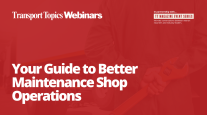Opinion: Timing Your Equipment Financing
By William Sutton
President and CEO
Equipment Leasing and Finance Association
This Opinion piece appears in the Jan. 7 print edition of Transport Topics. Click here to subscribe today.
Given today’s growing equipment demand and ongoing economic uncertainty, many businesses are finding noncash equipment financing to be a key acquisition strategy. The current market shows equipment financing — whether by lease, loan or line of credit — to be as vital and available as ever, enabling businesses to secure the assets they need while achieving their operational and financial objectives.
If you’ve made the decision to go the noncash route, the next consideration is timing, particularly now that the old year is winding down and the new year is upon us. Indeed, end-of-the-year incentives typically offered to trucking businesses by lenders and captive vendors put so much emphasis on leasing for noncash acquisitions at this time of year that it automatically feels like the right thing to do.
While such deals are often available at year-end, it’s important to keep financing in mind for acquiring the equipment your business needs, regardless of the time of year. A variety of available options, from commercial banks to smaller, more specialized commercial finance companies, can be found. The important thing is to determine your company’s needs and then choose whichever means of financing those acquisitions will be the most accommodating — and in the best timeframe — for your operation.
Of course, one reason leasing and finance companies typically do push to close transactions in December is to take advantage of any tax benefits during that particular fiscal year. Because of this predictable phenomenon, the Equipment Leasing and Finance Association’s monthly Leasing and Finance Index for December typically shows new business volume booming that month. When tax benefits for equipment leasing and finance companies exist, there should be an added incentive for them to offer better deals to customers.
Conversely, for company fleet managers, the push to complete equipment financing transactions by year-end may stem from a couple of scenarios: One is the ability to leverage the year’s unused operating funds to secure better terms or larger deals with financing companies eager to get deals done. The other is the need to maximize the allocated budget — the “use it or lose it” syndrome — to prevent it from being reabsorbed into the company and possibly cut from the next year’s budget.
In either case, it is recommended that businesses consult their accounting advisers to ensure they are getting the right equipment with the best possible terms.
Whether to acquire equipment in the last of 2012 is pretty much a moot point by the time you read this, but a close look at the following 10 key benefits of year-round equipment financing clearly show there’s no need to wait until the last chorus of “Auld Lang Syne” to acquire what your fleet needs.
1. Flexible financial solutions: The types of financing solutions equipment finance companies offer — leases in particular — are flexible and can be tailored to specific accounting, tax or cash flow needs.
2. Capital preservation: Financing versus spending cash — and particularly the type of financing employed, i.e., lease vs. loan — can help to mitigate the uncertainty of investing in a capital asset that may not yield the desired return or increase efficiency, cost savings or future sales.
3. Improved expense planning: Maintaining cash flow and consistent budgeting are additional benefits of equipment financing. Instead of considerable capital outlays resulting in huge budget fluctuations, financing enables even expense planning.
4. Business-cycle flexibility: Some types of leases allow for seasonal business fluctuations, lower monthly payments while a project is ramping up and revenue is not yet being generated from the equipment and other specific circumstances.
5. Up-to-date technology: Many businesses can’t afford to buy outright the equipment they need to be competitive and thrive. With term financing, they often are able to acquire more and better equipment that might have been out of their reach when the only consideration is buying it.
6. Equipment expertise: Many equipment finance companies are experts in specific types of equipment and offer specialties other financing sources do not. Equipment financiers have special relationships with manufacturers and distributors, specializing in certain equipment types or industry categories.
7. Managed obsolescence: Owning equipment outright includes the risk that it may become obsolete, a risk that is eliminated if you use lease financing for the acquisition. Most equipment finance companies, in partnership with their vendors, will work with your business to “right-size” the equipment for your specific needs.
8. Dependable asset management: Asset management is a key benefit of many forms of equipment finance, ensuring that equipment in operation isn’t being underutilized or overutilized. A good asset-management program tracks equipment throughout its life cycle from delivery to installation, use, maintenance and, finally, de-installation and disposition.
9. Equipment disposal: Most businesses don’t have the resources or knowledge to manage and sell their old equipment efficiently. You essentially may outsource the equipment-
management function so the financing company can handle its disposal or resale when the time comes to retire the asset.
10. Reduced risk: Equipment purchases involve risk to the owner, from equipment expertise to capital outlays, from asset management to obsolescence. Financing removes many unnecessary risks and distractions, allowing you to focus on your business.
The Equipment Leasing and Finance Association, Washington, D.C., represents companies in the $725 billion equipment-finance sector, which includes financial services companies and manufacturers engaged in financing capital goods.




